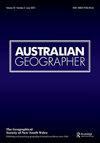Connected: rooftop solar, prepay and reducing energy insecurity in remote Australia
IF 2
2区 社会学
Q2 GEOGRAPHY
引用次数: 0
Abstract
ABSTRACT ‘It’s a good life, that solar’. Australia is a world leader in per-capita deployment of rooftop solar photovoltaics (PV) with more than three million households realising benefits including reduced energy bills and improved energy security. However, these benefits are unevenly distributed. Research shows First Nations residents of public housing in remote Australia using prepay metering experience frequent ‘self-disconnection’ from energy services, a known indicator of energy insecurity. Upfront capital costs and an absence of local regulations codifying the ability to connect solar PV have long locked out these households from realising benefits of energy transition in regions host to world class renewable energy generation potential. This article describes early experiences of those residents among the first to install and grid-connect rooftop solar to prepay in Australia’s remote Northern Territory. In addition to reduced electricity expenditures, rooftop solar PV mitigates experiences of energy insecurity through reducing the incidence of involuntary ‘self-disconnection’ due to inability to pay. Support for rooftop solar for prepay households can alleviate frequent exposure to disconnection, bringing multiple co-benefits. Policy responses should focus on reducing barriers to realising the benefits of rooftop PV for priority communities, including First Nations families living in public housing using prepay.互联:屋顶太阳能,预付费用,减少偏远澳大利亚的能源不安全
摘要“太阳能是美好的生活”。澳大利亚在屋顶太阳能光伏(PV)的人均部署方面处于世界领先地位,超过300万户家庭实现了包括减少能源账单和改善能源安全在内的好处。然而,这些利益分配不均。研究表明,在偏远的澳大利亚,使用预付费计量的公共住房的原住民居民经常与能源服务“断开连接”,这是一个已知的能源不安全指标。前期资本成本和缺乏规范太阳能光伏连接能力的地方法规,长期以来使这些家庭无法在拥有世界级可再生能源发电潜力的地区实现能源转型的好处。这篇文章描述了那些在澳大利亚偏远的北领地率先安装并联网屋顶太阳能预付款的居民的早期经历。除了减少电力支出外,屋顶太阳能光伏还通过减少因无力支付而非自愿“断开连接”的发生率来缓解能源不安全的体验。为预付费家庭提供屋顶太阳能支持可以缓解频繁的断开连接,带来多重共同利益。政策应对措施应侧重于减少优先社区实现屋顶光伏效益的障碍,包括使用预付款居住在公共住房中的原住民家庭。
本文章由计算机程序翻译,如有差异,请以英文原文为准。
求助全文
约1分钟内获得全文
求助全文
来源期刊

Australian Geographer
GEOGRAPHY-
CiteScore
4.10
自引率
8.30%
发文量
33
期刊介绍:
Australian Geographer was founded in 1928 and is the nation"s oldest geographical journal. It is a high standard, refereed general geography journal covering all aspects of the discipline, both human and physical. While papers concerning any aspect of geography are considered for publication, the journal focuses primarily on two areas of research: •Australia and its world region, including developments, issues and policies in Australia, the western Pacific, the Indian Ocean, Asia and Antarctica. •Environmental studies, particularly the biophysical environment and human interaction with it.
 求助内容:
求助内容: 应助结果提醒方式:
应助结果提醒方式:


